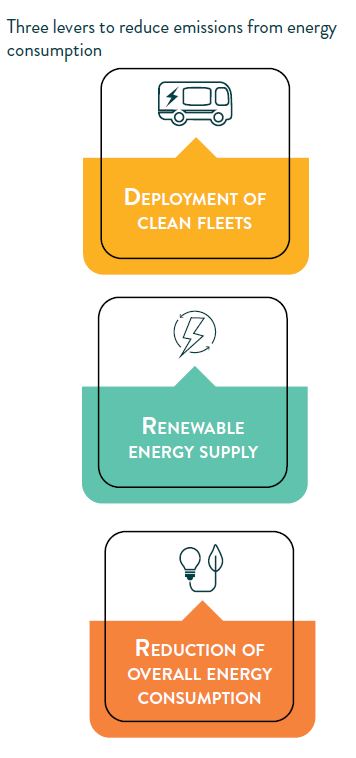
How should the public transport sector transition to renewable energy
The sector is working hard to reach net-zero
According to a survey of UITP members, 72% already have a carbon neutrality target or strategy. And 81% of operators and authorities already have an energy transition strategy. This includes both the electrification of vehicle fleets, such as buses, ferries, taxis and trains, and investing in fleets powered by other alternative energy sources such as hydrogen and biofuels.
However, rolling out the energy transition is not simply about the deployment of vehicles, it is about the deployment of a whole system; from the vehicles, to the charging infrastructures, adaptation of existing infrastructure, adaptation of operations and deployment of renewable energy assets.
For the sector to meet its decarbonisation objectives, it must invest in:
- New green fleets and providing access to green and renewable sources of energy.
- Renewable energy supply for existing fleets and all assets managed by public transport undertakings, such as offices, depots and stations.

For cities in search of achieving their climate objectives and Sustainable Development Goals (SDGs), deploying clean public transport fleets supplied with renewables and encouraging a modal shift towards public transport is the key. What’s more, renewable energy supply can be leveraged across other transport services and city services such as waste management ,and to support the local economy and energy market, all while improving public health.
UITP released a Report on renewable energy earlier this year, outlining how some of our members are delivering their climate goals. We’ve now delved deeper into the topic and released actionable recommendations for the sector as a whole. These Action Points, ‘How the public transport sector can transition to renewable energy’, offers guidance on how public transport undertakings can achieve a successful energy transition in line with their decarbonisation goals, while unlocking other social and financial benefits.
In the midst of uncertainties with global energy markets and the economic downturn, a transition to renewable sources can contribute to decarbonisation objectives, bring about greater financial stability, improve security of supply and modernise the customer offering. Operators, authorities and industry providers require greater support to understand exactly how to validate and launch such a major shift.
Laying the foundations for a successful energy transition
The strategic approach of the organisation is central to achieving the energy transition strategy, by setting up the scope, objectives and alignments with other strategic objectives of the city and organisation.
Local specificities should also be factored into the strategy, from understanding the local energy market and their legal context, complementing Sustainable Urban Mobility Plans and identifying the capacity of local stakeholders such as infrastructure suppliers.
When considering the decades of investment that such a shift requires, blending financial schemes and public-private investments can be an opportunity for public transport undertakings to finance the energy transition. According to the technology, application and context, investment opportunities will differ.
As we see in the European Union, the EU Taxonomy is a classification system establishing a list of environmentally sustainable economic activities and should be essential in directing investments towards sustainable projects and activities. As of 2026, it will only recognise transport ac¬tivities where direct (tailpipe) CO2 emissions are zero.

Recommendations
The publication providers further detail on the following four recommendations:
- Develop a strong strategy and net-zero targets which target all stakeholders.
- Assess how to renew fleets with pilots and data-driven operations.
- Understand the renewable energy supplies: The legal context, the energy market and relations with providers.
- Take extra care for the accounting, financing and acceptance of the energy transition.

The Bright Light of the City
As the UITP Global Public Transport Summit draws closer, we explore the innovations, research, and the people behind our six themes.
This article falls within the theme of Transitioning to Net Zero. We have several sessions dedicated the renewable energy such as “Managing energy in public transport operations: from renewable supply to intelligent charging management”, “Energy transition strategies in bus fleet renewal” and “Public transport as a decarbonisation leader: The importance of renewable energy supply”.
Discover the other themes and programme of the 2023 UITP Summit on uitpsummit.org! The UITP Global Public Transport Summit is the world’s biggest event dedicated to sustainable mobility which brings together all transport modes, industry authorities and operators, as well as exhibitors. Under the theme “Bright Light of the City”, access a wide range of thematic sessions, knowledge and networking opportunities in Barcelona from 4 to 7 June.








